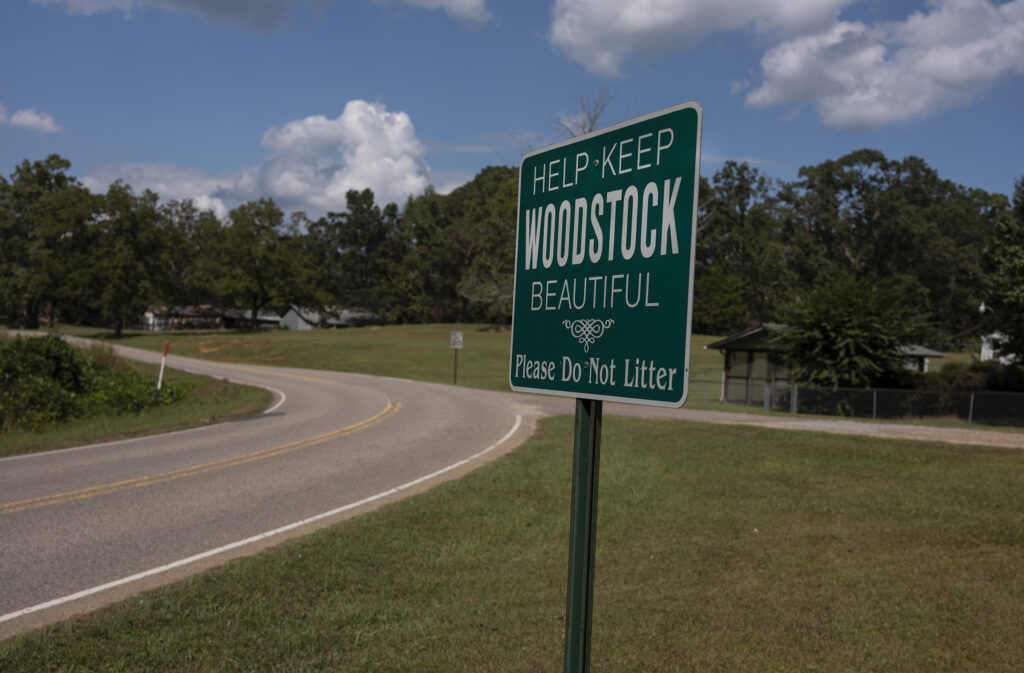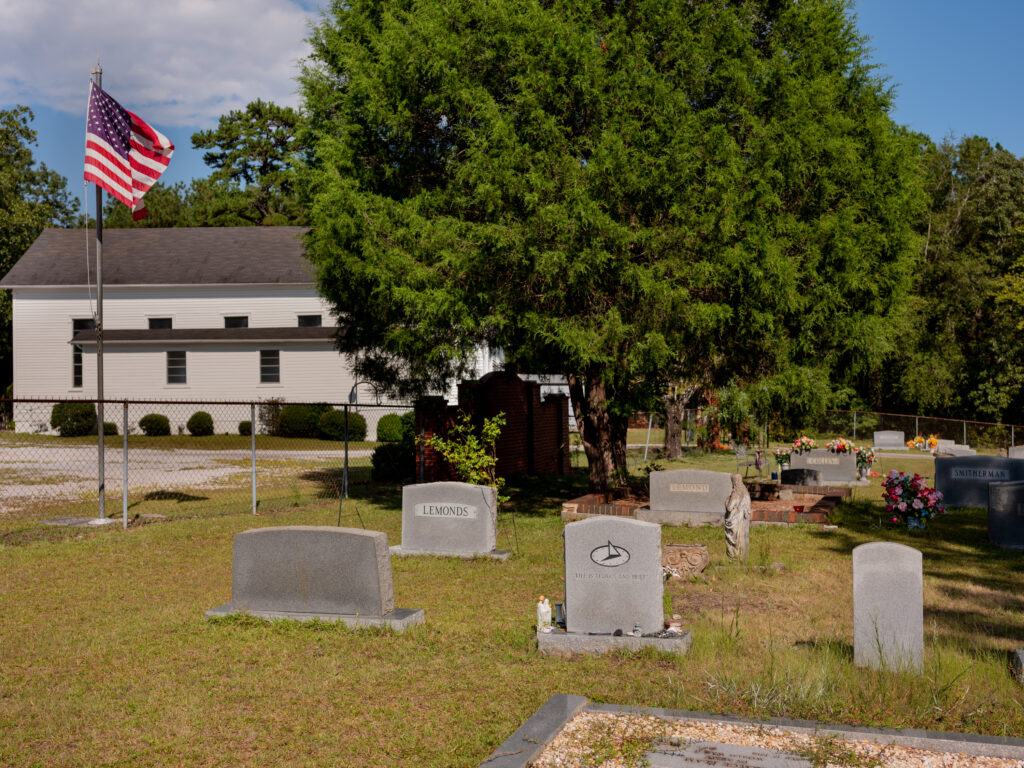Stuck in ‘S-Town’
When Cheryl Dodson was first contacted on Facebook by a reporter from out of town wanting to speak to her about her late friend John B. McLemore, she didn’t reply. “I couldn’t imagine what he wanted to discuss,” she said.
McLemore, Dodson’s friend of many years, had killed himself nearly two years prior. Dodson felt apprehensive about answering questions about his death and uncertain of the reporter’s intentions.
Months later, the reporter—Brian Reed, then of “This American Life”—tried again, this time calling Dodson on the phone. She agreed to meet with him at her home on his next trip to Woodstock, in Bibb County, Alabama.
She wanted to give Reed another perspective on McLemore, from the years before he’d sunk more deeply into depression, Dodson said. Reed had also referenced their connection: “He said my name kept coming up—I think it’s because I knew a different version of John than other people.”
When Reed arrived at her house for their interview in December 2016, Dodson’s guard was up. But, as time passed, she started to feel more at ease with sharing her memories of her friend: his loyalty, love of music, and outrageous sense of humor.
Often, the stigma around suicide means “you don’t get to grieve,” Dodson said. In talking to Reed, “I got to open up.” They spoke for about four hours. Dodson’s husband, Jeff, took a photograph of them together, Reed’s recorder sitting unassuming on the table between them.
Dodson recalled her “famous last words” to Jeff after Reed took his leave: “No one’s gonna listen to that.” Three months later, in March 2017, Reed’s new podcast, “S-Town,” was a global sensation, beating the records set by his team’s previous success, “Serial.” “S-Town” was downloaded 16 million times in the first week of its release and more than 40 million times in the first month.
For Dodson and others in Woodstock—a semi-rural community of just 1,500 people—“S-Town” was explosive. Not even Reed, however, could have anticipated that the series would continue to shape their lives, nearly a decade later.

“S-Town” was only the second-ever “blockbuster podcast,” following “Serial” in 2014, which investigated the 1999 killing of a Baltimore high school student. “Serial” transformed assumptions around what audio journalism could do; in 2015, it won a Peabody Award for its “innovations of form.”
“S-Town”—co-produced by Reed with “Serial”’s Julie Synder—was similarly ambitious. It presents initially as another true crime tale: Reed is asked by John B. McLemore, an NPR listener, to investigate a murder rumored to have taken place in his hometown.
But when that proves a dead end—the murder Reed was told about had never taken place—Reed’s focus changes to his local informant. McLemore is represented as a brilliant but troubled clockmaker consumed by contempt for his “shit town” of Woodstock. Reed had been corresponding with McLemore by email for more than two years and spent a week with him in Woodstock in late 2014. In June 2015, McLemore killed himself.
At that time, they’d not yet agreed on a new focus or narrative for Reed’s reporting. But instead of abandoning the project, Reed decided to make McLemore the story. His death is confirmed at the end of the second episode and serves as a catalyst for Reed’s investigation into his life.
There “wasn’t one decision” made to continue with the project, Reed said. The reporter had been actively engaged with McLemore in finding a new direction for the podcast and was planning another trip to Woodstock in the weeks before McLemore killed himself. “It wasn’t like I’d moved on,” he said.
When he returned to Woodstock to attend McLemore’s funeral, he encountered more questions—about McLemore’s estate and whether his wishes were being honored—that invited more reporting.
In the 18 months after McLemore’s death, Reed returned to Woodstock some 10 times to interview his friends, family, and neighbors, putting together a picture of his unique life and the fallout from his death.
“Eventually, it became clear: this is worth doing,” said Reed. “There are important, meaningful things to get into here that can illuminate things about our country, about the world, about relationships that we don’t often get to hear about. Those were the reasons that I felt the story deserved to exist.”
But, Reed said, he had no idea that “S-Town” would generate the response it did. He saw it as a “particular” story that might gain a cult following at best. “I certainly didn’t picture flying to Australia to talk to thousands of people about it.”
“S-Town” was widely praised for its moving portrayal of McLemore and its insights into depression, isolation, and life in the South. Like “Serial,” it was also credited with pushing the then-nascent medium into new territory, and was awarded a Peabody “as a pioneering classic of the form.”
While the earlier series had been inspired by television, “S-Town”’s scope was explicitly novelistic with its larger-than-life central character, sustained metaphors, and structure of “chapters.” The Atlantic declared “S-Town” proof of “audio journalism’s potential as art”; Slate considered it akin to “aural literature.” Journalist Jon Ronson called it “the best podcast I’ve ever heard” having only listened to two episodes.
Unlike “Serial,” which hooked audiences with weekly episodes, all seven chapters of “S-Town” were made available at once: a novel innovation at the time. Reed said it was done in the hopes of tamping down audiences’ impulse “to theorize about real people”: “From ‘Serial’ season one, we knew that there could be a bit of a frenzy.”
But in the wave of acclaim for “S-Town” only so much could be done to stem listeners’ enthusiasm. Weeks after its release, strangers traveled to Woodstock to take selfies at featured locations and visit McLemore’s grave. Someone flew a drone over the maze he had been growing on his property and posted the footage on YouTube (it now has 137,000 views).
Meanwhile, questions posed in the podcast—about whether McLemore had mercury poisoning or hidden bars of gold—stoked the interest of citizen detectives. The dedicated “S-Town” subreddit has 11,000 subscribers, and remains active today (though posts have slowed in recent years). In 2021, a TikTok creator posted a tour of McLemore’s abandoned house, drawing attention to the sink in which he used to urinate.
Such a response is now a familiar part of true crime culture: the appetite for tragic narratives drawn from life and audiences’ tendency to involve themselves in the story. But back in 2017, the sudden spotlight on Woodstock was a shock.

When Cheryl Dodson sat down with Reed, she had no idea that the podcast would reach so many people. She hadn’t even thought to tell her five children about the interview. “I really didn’t think it would be popular in our area,” she said.
After “S-Town”’s release, Dodson was besieged with dozens of messages and Facebook notifications. “My friends were texting me, because they knew I knew John: ‘Do you know about this?’ I said, ‘I haven’t heard it, but I’m in it.’ I was just in a panic.”
She had already grieved her friend privately, and hadn’t anticipated that “S-Town” would not only reopen the wound, but probe it. “Hearing his voice again was devastating. It took me a week to get through the podcast.”
In pride of place on Dodson’s mantelpiece, visible behind her on Zoom, is an elaborate clock bearing the mark of Diana the huntress; McLemore’s work, she confirmed. Dodson salvaged it from his workshop only last year, where it had somehow escaped the notice of trespassers in the years since “S-Town.”
Though their relationship wasn’t without conflict, “he had a beautiful side with me that I’m protective of,” Dodson said. But after the podcast’s release, she found herself called on to explain her decades-long friendship with McLemore, and even defend herself.
On social media, listeners accused Dodson of not doing enough to help him or exaggerating their friendship for clout. The attention was “continuous,” she said, and across different time zones; Dodson lost sleep. “It made the world a lot smaller for me.”
She was tagged in the obituaries of people who’d died by suicide, by strangers “trying to say it was a similar circumstance.” Once, Dodson posted on Facebook about getting a pedicure; someone chided her for putting her feet up instead of her hand out to McLemore. Dodson said a few trolls seemed to spend “every hour of the day” haranguing her.
The response wasn’t limited to the digital realm. In public, Dodson encountered people who assumed knowledge of her. “I had experts on my life,” she said. One day she was out with her husband and a stranger called their dog by name. She assumed that he was an “S-Town” fan who’d been trawling her social media. “I couldn’t escape it,” she said. “It was everywhere—and not just for me.”
By her own admission, Dodson was “edited kindly” in “S-Town.” But the show couldn’t help but implicate real people in its storylines. After McLemore’s death, the estate battle looming between McLemore’s cousin, Reta Lawrence, and his young friend, Tyler Goodson, became one of the podcast’s primary threads.

In “S-Town: Behind the scenes,” a blog Lawrence maintained for a few months in 2018, she described the fallout from the podcast as “a mental and physical nightmare.” She did not regret participating, she wrote, nor did she specify any fault with Reed’s reporting, but “the way some people perceive me changed forever.” (Lawrence did not respond to a request for comment.)
Goodson also spoke of the toll, telling Esquire in 2018: “It’s hell being famous without the rich part.” His attempts to cash in on “S-Town”’s success with a T-shirt line had not proved viable; meanwhile, strangers routinely trespassed on his property, wanting to take pictures. (Goodson labeled himself, on his failed T-shirt line, the “black sheep of S-Town.”)
Even today, nearly eight years after “S-Town,” it continues to draw visitors to Woodstock wanting to pay their respects to McLemore or just rubberneck. Despite its often unflattering portrayal in the podcast, the town has acknowledged its impact with a dedicated display in the community library. “It’s gotten that little small area around there more publicity,” said McLemore’s friend, William R. Tatum, who appears in the podcast as Bill. “John B. put them on the map.”
Tatum was first contacted by Reed in 2015, days after learning of McLemore’s death from an online obituary. He didn’t even know there was a podcast in production: “I was kind of in shock,” he said. Like Dodson, Tatum was initially reluctant to be interviewed, as a “low-profile kind of person,” but he and Reed went on to have several conversations. Tatum has listened to “S-Town” three or four times since, and appreciated it as a tribute to McLemore, “probably the smartest individual I’ve ever met. I can almost picture him, telling funny stories.”
An antique clock collector, Tatum was first introduced to McLemore as a rare restorer “who knew what he was doing.” Last year, he loaned 40-odd clocks that McLemore had worked on to the National Watch & Clock Museum in Columbia, Pa., for a dedication exhibition; Tatum also co-authored the accompanying book.
Tatum is not bothered by his friend’s posthumous fame, he said, but he does seem somewhat bemused by it. “The first time I met him, I didn’t think there was going to be a book, a podcast, a New York Times article—it was just inconceivable.”
There remains the uneasy question of what McLemore himself would have made of the series had he lived to hear it. Though he’d written to Reed pitching an investigation into his hometown, the story that was eventually produced revealed intimate details about his mental health, relationships, and sexuality.
Even positive reviews of “S-Town” upon its release in 2017 expressed misgivings about the intrusion into McLemore’s privacy; he had not been a public figure, nor alive to give his consent. For some, it provoked the question of whether “S-Town” could be considered journalism at all.
Gay Alcorn, writing in The Guardian, said that it “crossed over into voyeurism” with its disclosures about McLemore’s sexuality and intimate relationships with men. At Vox, Aja Romano criticized the series for teasing his queer identity “as a major dramatic plot point,” and the presentation of his drunken, ritualistic pursuit of pain (along with Goodson, in sessions they termed “church”) as disordered, rather than a known fetish.
Reed was taken aback by the criticism, he said. “I was just like, ‘This seems like pretty standard journalism to me, actually.’” He sees “S-Town” as belonging “pretty squarely” to the tradition of narrative nonfiction such as “Into The Wild,” Jon Krakauer’s 1996 book about the life and death of Chris McCandless.
Though the details of McLemore’s life were “certainly hard to hear, and personal,” each inclusion reflected careful editorial decision-making and consideration of his relationship with McLemore, Reed said. “I knew this man; he was eager to have a story told. There was a will there, that I knew from our relationship. That said, there are absolutely parts of the story that he didn’t know would be done.”
Another uneasy tension presented by “S-Town” was the gap between its subject and its producers and assumed audience. In 2020, Louisiana State University academic Michael Bibler wrote that “S-Town” was reductive of the South, as well as McLemore, in its emphasis on Woodstock as rural and isolated—it’s not far from cities like Birmingham and Tuscaloosa—and invocation of “a worn narrative of southern gothic dysfunction.”
Collin Bjork, an academic writing a book about true crime podcasting who taught classes on “S-Town” while working at Indiana University in 2018, agreed that Reed “tapped into those assumptions,” foregrounding a personal narrative over context and structural forces.
McLemore might have been playing up to them too, suggested Bjork. “It does seem to some extent that he knows what he’s doing, that he knows that this mystery thing will be irresistible to a big-city journalist, and that he’s a character.”
But the decisions made in “S-Town” are undeniably complicated by the absence of its central character, Bjork said. “It pulls the true crime tropes to get the listeners to hop in directly on the coattails of ‘Serial,’ and then it’s a feint.”
Relistening to the podcast this year, Bjork was struck by the “sensuous” language Reed used when reporting on McLemore’s intimate relationships, as well as the off-the-record details that made it into the show. “There’s a voyeuristic quality to that episode that I’ve seen subsequently in true crime. The consumption of sexuality and participation in sexual desire—it’s all there, and I think there’s a long through line of that today.”
To Bjork, “S-Town” “really brings those questions about what is journalism and its role to the fore.” That debate has only intensified in the years since, he added. “I devoured ‘S-Town’ the first time I listened to it; I couldn’t wait to teach it. This time around, I was questioning ‘whose right is it to tell this story?’ in a way that I didn’t 10 years ago.”
Reed, too, has been grappling with “S-Town” and its legacy. In 2018, he was sued by McLemore’s estate which was seeking profits from the podcast on the grounds that it was exploitative. A settlement was reached in 2020 (neither party has said whether money was exchanged).
In fighting the lawsuit, Reed had to prove that “S-Town” was a work of journalism. “That, I just found so disorienting,” he said. “Maybe you take issue with decisions I made, maybe you don’t think it’s a good story, maybe you think it’s harmful—but that it’s not journalism, I found very hard to square.”
No one involved in the production of “S-Town” had been unhappy with his reporting, Reed claimed. A local lawyer established the estate for McLemore against his family’s wishes and filed the lawsuit under Alabama’s new Right of Publicity law.
Such laws mostly exist to protect celebrities from others profiting off their image in advertisements, making “S-Town” an unusual application. Legal experts interviewed by The New York Times in 2018 said the case would be unlikely to succeed had it gone to court. But the attempt speaks to the risks of drawing narratives from real life, particularly at a time when they can reach audiences of millions.
Cooper Shattuck, who helped draft the Alabama law and represented the plaintiff against Reed and Serial Productions, remembered it as a unique case, not least because of the genre-defying nature of “S-Town.”
“It’s an interesting bird—it’s not just a podcast where people are interviewed, but it wasn’t a creative work that Brian Reed sat down and wrote,” Shattuck said. To him, the case was illustrative of how the law lags behind culture in the internet age. “I think the courts are going to have to wrestle with that.”
For Reed, the experience of being sued prompted some soul-searching, not only about his own work, but the state of journalism itself. “There’s just wide disagreement about what it is, how it should be done, who gets to do it, what its purpose is, where it should aim. I think a lot of us have a feeling that it’s not living up to what it should be.”
His new podcast, “Question Everything,” aims to progress that conversation, using “the tools of journalism to re-examine journalism” and he started with “S-Town.” In the first episode, Reed sat down with the Guardian critic Gay Alcorn who called the series “morally indefensible” and defended his decision-making.
Their conversation is uncomfortable, challenging, and self-reflective, as Reed faces Alcorn’s and others’ criticisms of “S-Town” publicly for the first time. Though he stands by the series, Reed is—as he admits in their interview—“a little dismissive and maybe a little defensive” of the critiques at the time.
The criticism of “S-Town” that resonated with Reed most, he tells me, was about its handling of racism in Woodstock and how he potentially alienated Black listeners in favor of building empathy for its central characters. His following series—“The Trojan Horse Affair” in 2022, about an Islamophobic hoax in Birmingham, England—was born, in part, of a desire to tell a more outwards-looking story focused on injustice, he said.
Having spoken to Alcorn, Reed continued, he can better see her point: “S-Town” would have benefited from greater transparency about the choices and decisions that went into making it. “What I’ve come to understand is that explaining my reasoning—answering questions that you’re asking here, about ‘how did you decide to do this?’ more explicitly—that’s the thing I would change, probably, and do more of in the show,” said Reed. “That you leave wondering how the decision was made? It’d be better if you didn’t.”
In the meantime, life has carried on for the people of Woodstock, unbound by the constraints of narrative episodes. For Dodson, its lasting impact has been her work in suicide prevention, which gave her “motivation and a purpose” when she felt powerless.
In her five years with the Alabama Suicide Prevention and Resources Coalition, Dodson has helped to train over 10,000 people in responding to suicide risks and raised thousands of dollars for the cause. In May 2024, she spoke at the American Association of Suicidology Conference in Las Vegas.
That work, and the online connections she forged with “S-Town” listeners who related to McLemore’s struggles, have helped Dodson make her peace with the podcast. “I’m glad they captured him. What John could do so well was voice his pain, as tragic as that is, and I think he saved some lives with it.”
In December last year, Tyler Goodson was shot dead by police following a reported standoff at his house. An investigation is ongoing, but for fans of “S-Town”—which dealt with Goodson’s life of hardship, as well as McLemore’s hope that he could turn it around—the news was tragic. “It’s something out of John’s worst nightmare,” said Reed, who traveled to Woodstock to attend Goodson’s memorial service. In May 2017, during that first flurry of media attention on Woodstock, Goodson spoke to a reporter about “S-Town.” “It’s a sad story,” he said, “especially if you’re part of it.”
![]()
Elle Hunt is a U.K.-based writer working mostly for The Guardian.










